Augmented Reality in the Science Classroom—Implementing Pre-Service Teacher Training in the Competency Area of Simulation and Modeling According to the DiKoLAN Framework
Abstract
1. Introduction
2. Theoretical Frameworks
2.1. DiKoLAN—Digital Competencies for Teaching in Science Education
2.2. Theory of Planned Behavior
3. Methods and Materials
3.1. Sample
3.2. Instruments
3.2.1. Questionnaire on Self-Efficacy Expectations Regarding Digital Competencies for Teaching in Science Education in the Competency Area of Simulation and Modeling
3.2.2. Questionnaire for Assessing Attitudes towards AR in Science Education
- Attitudes towards learning with AR in the classroom (ATT);
- Motivational orientation to the use of AR in the classroom (MOT);
- Subjective norm expectations for the use of AR (SUB);
- Self-efficacy expectations on the use of AR (SEE);
- Perceived constraints to the use of AR (CON).
3.3. Study Design
3.4. Course Design
3.4.1. Model Theory
3.4.2. Simulations
3.4.3. Interventions
3.5. Statistical Analysis
4. Results
4.1. Study 1—Increase in DiKoLAN-Related Self-Efficacy Expectations
4.2. Study 2—Increase in AR-Related Self-Efficacy Expectations
5. Discussion
Limitations
6. Conclusions
Author Contributions
Funding
Institutional Review Board Statement
Informed Consent Statement
Data Availability Statement
Acknowledgments
Conflicts of Interest
Appendix A
| Item | Itemtext |
|---|---|
| Attitudes towards learning with Augmented Reality (AR) in the classroom (ATT) | |
| ATT01 | Augmented Reality should generally be given significant emphasis in school curricula. |
| ATT02 * | The use of Augmented Reality in schools leads to a flattening of the level of instruction. |
| ATT03 * | Negative consequences of Augmented Reality for learning are underestimated. |
| ATT04 | The use of Augmented Reality enables a high degree of self-directed learning. |
| ATT05 | Through the use of Augmented Reality, students can be better motivated to learn. |
| ATT06 | Computers and Augmented Reality open up opportunities for creativity in learning. |
| ATT07 | The use of Augmented Reality in schools ensures that children are well-prepared for their professional lives. |
| ATT08 | Learning with Augmented Reality is an efficient form of learning. |
| ATT09 | With Augmented Reality, I can plan and adapt lessons more effectively for the target audience. |
| ATT10 | Augmented Reality allows for higher student engagement. |
| Motivational orientation to the use of Augmented Reality (AR) in the classroom (MOT) | |
| MOT01 | It brings me joy to think about how I can use Augmented Reality in the classroom. |
| MOT02 | Even in my free time, I research the possibilities of incorporating Augmented Reality into teaching. |
| MOT03 | I enjoy familiarizing myself with the operation of Augmented Reality for teaching. |
| MOT04 | I am willing to invest some extra time in lesson preparation if it allows me to use Augmented Reality in the classroom. |
| MOT05 | I am very excited to consider how I can better support my students’ learning with the help of Augmented Reality. |
| MOT06 | Selecting or creating Augmented Reality for teaching is one of the most interesting parts of lesson preparation. |
| Subjective norm expectations for the use of AR (SUB) | |
| SUB01 | The curriculum demands the use of Augmented Reality. |
| SUB02 | Students value the use of Augmented Reality in the classroom. |
| SUB03 | My fellow students believe that Augmented Reality is an essential element of contemporary teaching. |
| SUB04 | Supervisors expect the use of Augmented Reality during teacher training. |
| SUB05 | Lecturers in my teacher education program consider it important to use Augmented Reality in teaching. |
| SUB06 | Teachers in schools believe that Augmented Reality must be part of instruction. |
| Self-efficacy expectations on the use of Augmented Reality (AR) (SEE) | |
| SEE01 * | I will find it difficult to conduct experiments using Augmented Reality in the classroom. |
| SEE02 | I am confident in creating Augmented Reality for my teaching. |
| SEE03 | I am certain that I can implement Augmented Reality-based experiments in the classroom. |
| SEE04 * | I find it challenging to explain to my students how to operate Augmented Reality. |
| SEE05 | All in all, it is very easy for me to incorporate suitable Augmented Reality into lesson planning. |
| SEE06 | Modeling a phenomenon or process in the classroom using Augmented Reality is not difficult for me. |
| SEE07 | I am generally capable of purposefully using Augmented Reality applications in teaching. |
| SEE08 | I know how to design lessons in which students can learn to create Augmented Reality. |
| Perceived constraints to the use of AR (CON) | |
| CON01 * | The lengthy preparation time often prevents me from incorporating Augmented Reality. |
| CON02 * | The high technical effort often prevents me from incorporating Augmented Reality. |
| CON03 | The equipment in schools allows for seamless integration of Augmented Reality into lesson planning. |
| CON04 * | Sometimes I lack the necessary knowledge to incorporate Augmented Reality into lesson planning. |
| CON05 | It heavily depends on the discipline of the students in class whether I incorporate Augmented Reality into lesson planning. |
| CON06 | I often have ideas for the use of Augmented Reality. |
References
- Tschiersch, A.; Krug, M.; Huwer, J.; Banerji, A. Augmented Reality in chemistry education—An overview. CHEMKON 2021, 28, 241–244. [Google Scholar] [CrossRef]
- Azuma, R.T. A Survey of Augmented Reality. Presence Teleoper. Virtual Environ. 1997, 6, 355–385. [Google Scholar] [CrossRef]
- Buchner, J.; Kerres, M. Media comparison studies dominate comparative research on augmented reality in education. Comput. Educ. 2023, 195, 104711. [Google Scholar] [CrossRef]
- Sahin, D.; Yilmaz, R.M. The effect of Augmented Reality Technology on middle school students’ achievements and attitudes towards science education. Comput. Educ. 2020, 144, 103710. [Google Scholar] [CrossRef]
- Akçayır, M.; Akçayır, G. Advantages and challenges associated with augmented reality for education: A systematic review of the literature. Educ. Res. Rev. 2017, 20, 1–11. [Google Scholar] [CrossRef]
- Garzón, J.; Acevedo, J. Meta-analysis of the impact of Augmented Reality on students’ learning gains. Educ. Res. Rev. 2019, 27, 244–260. [Google Scholar] [CrossRef]
- Lu, S.J.; Liu, Y.C.; Chen, P.J.; Hsieh, M.R. Evaluation of AR embedded physical puzzle game on students’ learning achievement and motivation on elementary natural science. Interact. Learn. Environ. 2020, 28, 451–463. [Google Scholar] [CrossRef]
- Allcoat, D.; Hatchard, T.; Azmat, F.; Stansfield, K.; Watson, D.; Von Mühlenen, A. Education in the Digital Age: Learning Experience in Virtual and Mixed Realities. J. Educ. Comput. Res. 2021, 59, 795–816. [Google Scholar] [CrossRef]
- Chao, J.; Chiu, J.L.; DeJaegher, C.J.; Pan, E.A. Sensor-Augmented Virtual Labs: Using Physical Interactions with Science Simulations to Promote Understanding of Gas Behavior. J. Sci. Educ. Technol. 2016, 25, 16–33. [Google Scholar] [CrossRef]
- Chiu, J.L.; DeJaegher, C.J.; Chao, J. The effects of augmented virtual science laboratories on middle school students’ understanding of gas properties. Comput. Educ. 2015, 85, 59–73. [Google Scholar] [CrossRef]
- Tarng, W.; Lin, Y.J.; Ou, K.L. A Virtual Experiment for Learning the Principle of Daniell Cell Based on Augmented Reality. Appl. Sci. 2021, 11, 762. [Google Scholar] [CrossRef]
- Fidan, M.; Tuncel, M. Integrating augmented reality into problem based learning: The effects on learning achievement and attitude in physics education. Comput. Educ. 2019, 142, 103635. [Google Scholar] [CrossRef]
- Hsiao, K.F.; Chen, N.S.; Huang, S.Y. Learning while exercising for science education in augmented reality among adolescents. Interact. Learn. Environ. 2012, 20, 331–349. [Google Scholar] [CrossRef]
- De Micheli, A.J.; Valentin, T.; Grillo, F.; Kapur, M.; Schuerle, S. Mixed Reality for an Enhanced Laboratory Course on Microfluidics. J. Chem. Educ. 2022, 99, 1272–1279. [Google Scholar] [CrossRef]
- Czok, V.; Krug, M.; Müller, S.; Huwer, J.; Kruse, S.; Müller, W.; Weitzel, H. A Framework for Analysis and Development of Augmented Reality Applications in Science Teaching. Educ. Sci. 2023, 13, 926. [Google Scholar]
- Thees, M.; Kapp, S.; Strzys, M.P.; Beil, F.; Lukowicz, P.; Kuhn, J. Effects of augmented reality on learning and cognitive load in university physics laboratory courses. Comput. Hum. Behav. 2020, 108, 106316. [Google Scholar] [CrossRef]
- Sirakaya, M.; Alsancak Sirakaya, D. Trends in Educational Augmented Reality Studies: A Systematic Review. Malays. Online J. Educ. Technol. 2018, 6, 60–74. [Google Scholar] [CrossRef]
- Cai, S.; Wang, X.; Chiang, F.K. A case study of Augmented Reality simulation system application in a chemistry course. Comput. Hum. Behav. 2014, 37, 31–40. [Google Scholar] [CrossRef]
- Jones, L.L.; Kelly, R.M. Visualization: The Key to Understanding Chemistry Concepts. In ACS Symposium Series; Orna, M.V., Ed.; American Chemical Society: Washington, DC, USA, 2015; Volume 1208, pp. 121–140. [Google Scholar] [CrossRef]
- Rodríguez, F.C.; Frattini, G.; Krapp, L.F.; Martinez-Hung, H.; Moreno, D.M.; Roldán, M.; Salomón, J.; Stemkoski, L.; Traeger, S.; Dal Peraro, M.; et al. MoleculARweb: A Web Site for Chemistry and Structural Biology Education through Interactive Augmented Reality out of the Box in Commodity Devices. J. Chem. Educ. 2021, 98, 2243–2255. [Google Scholar] [CrossRef]
- Fombona-Pascual, A.; Fombona, J.; Vicente, R. Augmented Reality, a Review of a Way to Represent and Manipulate 3D Chemical Structures. J. Chem. Inf. Model. 2022, 62, 1863–1872. [Google Scholar] [CrossRef]
- Domínguez Alfaro, J.L.; Gantois, S.; Blattgerste, J.; De Croon, R.; Verbert, K.; Pfeiffer, T.; Van Puyvelde, P. Mobile Augmented Reality Laboratory for Learning Acid–Base Titration. J. Chem. Educ. 2022, 99, 531–537. [Google Scholar] [CrossRef]
- Wong, C.H.S.; Tsang, K.C.K.; Chiu, W.K. Using Augmented Reality as a Powerful and Innovative Technology to Increase Enthusiasm and Enhance Student Learning in Higher Education Chemistry Courses. J. Chem. Educ. 2021, 98, 3476–3485. [Google Scholar] [CrossRef]
- Mystakidis, S.; Fragkaki, M.; Filippousis, G. Ready Teacher One: Virtual and Augmented Reality Online Professional Development for K-12 School Teachers. Computers 2021, 10, 134. [Google Scholar] [CrossRef]
- Wahyu, Y.; Suastra, I.W.; Sadia, I.W.; Suarni, N.K. The Effectiveness of Mobile Augmented Reality Assisted STEM-Based Learning on Scientific Literacy and Students’ Achievement. Int. J. Instr. 2020, 13, 343–356. [Google Scholar] [CrossRef]
- Teichrew, A.; Erb, R. How augmented reality enhances typical classroom experiments: Examples from mechanics, electricity and optics. Phys. Educ. 2020, 55, 065029. [Google Scholar] [CrossRef]
- Eriksen, K.; Nielsen, B.E.; Pittelkow, M. Visualizing 3D Molecular Structures Using an Augmented Reality App. J. Chem. Educ. 2020, 97, 1487–1490. [Google Scholar] [CrossRef]
- Milgram, P.; Takemura, H.; Utsumi, A.; Kishino, F. Augmented Reality: A Class of Displays on the Reality-Virtuality Continuum; SPIE: Boston, MA, USA, 1995; pp. 282–292. [Google Scholar] [CrossRef]
- Pan, Z.; López, M.F.; Li, C.; Liu, M. Introducing augmented reality in early childhood literacy learning. Res. Learn. Technol. 2021, 29, 2539. [Google Scholar] [CrossRef]
- Wu, H.K.; Lee, S.W.Y.; Chang, H.Y.; Liang, J.C. Current status, opportunities and challenges of augmented reality in education. Comput. Educ. 2013, 62, 41–49. [Google Scholar] [CrossRef]
- Krug, M.; Huwer, J. Safety in the Laboratory—An Exit Game Lab Rally in Chemistry Education. Computers 2023, 12, 67. [Google Scholar] [CrossRef]
- Erbas, C.; Demirer, V. The effects of augmented reality on students’ academic achievement and motivation in a biology course. J. Comput. Assist. Learn. 2019, 35, 450–458. [Google Scholar] [CrossRef]
- Khan, T.; Johnston, K.; Ophoff, J. The Impact of an Augmented Reality Application on Learning Motivation of Students. Adv. Hum.-Comput. Interact. 2019, 2019, 7208494. [Google Scholar] [CrossRef]
- Syskowski, S.; Huwer, J. A Combination of Real-World Experiments and Augmented Reality When Learning about the States of Wax—An Eye-Tracking Study. Educ. Sci. 2023, 13, 177. [Google Scholar] [CrossRef]
- Huwer, J.; Barth, C.; Siol, A.; Eilks, I. Combining reflections on education for sustainability and digitalization—Learning with and about the sustainable use of tablets along an augmented reality learning environment. CHEMKON 2021, 28, 235–240. [Google Scholar] [CrossRef]
- Probst, C.; Fetzer, D.; Lukas, S.; Huwer, J. Effects of using augmented reality (AR) in visualizing a dynamic particle model. CHEMKON 2022, 29, 164–170. [Google Scholar] [CrossRef]
- Akçayır, M.; Akçayır, G.; Pektaş, H.M.; Ocak, M.A. Augmented reality in science laboratories: The effects of augmented reality on university students’ laboratory skills and attitudes toward science laboratories. Comput. Hum. Behav. 2016, 57, 334–342. [Google Scholar] [CrossRef]
- Singh, G.; Mantri, A.; Sharma, O.; Dutta, R.; Kaur, R. Evaluating the impact of the augmented reality learning environment on electronics laboratory skills of engineering students. Comput. Appl. Eng. Educ. 2019, 27, 1361–1375. [Google Scholar] [CrossRef]
- Li, F.; Wang, X.; He, X.; Cheng, L.; Wang, Y. How augmented reality affected academic achievement in K-12 education—A meta-analysis and thematic-analysis. In Interactive Learning Environments; Taylor & Francis Group: Abingdon, UK, 2021; pp. 1–19. [Google Scholar] [CrossRef]
- Lin, T.J.; Duh, H.B.L.; Li, N.; Wang, H.Y.; Tsai, C.C. An investigation of learners’ collaborative knowledge construction performances and behavior patterns in an augmented reality simulation system. Comput. Educ. 2013, 68, 314–321. [Google Scholar] [CrossRef]
- Knoll, M.; Stieglitz, S. Augmented Reality und Virtual Reality—Einsatz im Kontext von Arbeit, Forschung und Lehre. HMD Prax. Der Wirtsch. 2022, 59, 6–22. [Google Scholar] [CrossRef]
- Gomollón-Bel, F. IUPAC Top Ten Emerging Technologies in Chemistry 2022: Discover the innovations that will transform energy, health, and materials science, to tackle the most urgent societal challenges and catalyse sustainable development. Chem. Int. 2022, 44, 4–13. [Google Scholar] [CrossRef]
- Brinkmann, B.; Müller, U. Lehramtsstudium in der Digitalen Welt—Professionelle Vorbereitung auf den Unterricht Mit Digitalen Medien?! Technical Report; CHE Centrum für Hochschulentwicklung gGmbH: Gütersloh, Germany, 2018; 24p. [Google Scholar]
- Jang, J.; Ko, Y.; Shin, W.S.; Han, I. Augmented Reality and Virtual Reality for Learning: An Examination Using an Extended Technology Acceptance Model. IEEE Access 2021, 9, 6798–6809. [Google Scholar] [CrossRef]
- Henne, A.; Möhrke, P.; Thoms, L.J.; Huwer, J. Implementing Digital Competencies in University Science Education Seminars Following the DiKoLAN Framework. Educ. Sci. 2022, 12, 356. [Google Scholar] [CrossRef]
- Vogelsang, C.; Finger, A.; Laumann, D.; Thyssen, C. Vorerfahrungen, Einstellungen und motivationale Orientierungen als mögliche Einflussfaktoren auf den Einsatz digitaler Werkzeuge im naturwissenschaftlichen Unterricht. Z. Didakt. Naturwissenschaften 2019, 25, 115–129. [Google Scholar] [CrossRef]
- Becker, S.; Bruckermann, T.; Finger, A.; Huwer, J.; Kremser, E.; Meier, M.; Thoms, L.J.; Thyssen, C.; Kotzebue, L.v. Orientierungsrahmen Digitale Kompetenzen für das Lehramt in den Naturwissenschaften—DiKoLAN. In Digitale Basiskompetenzen – Orientierungshilfe und Praxisbeispiele für die Universitäre Lehramtsausbildung in den Naturwissenschaften; Becker, S., Meßinger-Koppelt, J., Thyssen, C., Eds.; Joachim Herz Stiftung: Hamburg, Germany, 2020; pp. 13–43. [Google Scholar]
- Kotzebue, L.V.; Meier, M.; Finger, A.; Kremser, E.; Huwer, J.; Thoms, L.J.; Becker, S.; Bruckermann, T.; Thyssen, C. The Framework DiKoLAN (Digital Competencies for Teaching in Science Education) as Basis for the Self-Assessment Tool DiKoLAN-Grid. Educ. Sci. 2021, 11, 775. [Google Scholar] [CrossRef]
- Thoms, L.J.; Meier, M.; Huwer, J.; Thyssen, C.; Kotzebue, L.; Becker, S.; Kremser, E.; Finger, A.; Bruckermann, T. DiKoLAN—A Framework to Identify and Classify Digital Competencies for Teaching in Science Education and to Restructure Pre-Service Teacher Training. In Proceedings of the Society for Information Technology & Teacher Education International Conference, Online, 29 March 2021; Langran, E., Archambault, L., Eds.; Association for the Advancement of Computing in Education (AACE): Waynesville, NC, USA, 2021; pp. 1652–1657. [Google Scholar]
- Redecker, C. European Framework for the Digital Competence of Educators: DigCompEdu; European Union Office: Luxembourg, 2017; ISBN 978-92-79-73494-6. [Google Scholar] [CrossRef]
- Koehler, M.J.; Mishra, P.; Cain, W. What is Technological Pedagogical Content Knowledge (TPACK)? J. Educ. 2013, 193, 13–19. [Google Scholar] [CrossRef]
- Huwer, J.; Irion, T.; Kuntze, S.; Schaal, S.; Thyssen, C. Von TPaCK zu DPaCK—Digitalisierung im Unterricht erfordert mehr als technisches Wissen. MNU J. 2019, 72, 358–364. [Google Scholar]
- Ajzen, I. The theory of planned behavior. Organ. Behav. Hum. Decis. Process. 1991, 50, 179–211. [Google Scholar] [CrossRef]
- Graf, D. Die Theorie des Geplanten Verhaltens. In Theorien in der Biologiedidaktischen Forschung; Krüger, D., Vogt, H., Eds.; Springer-Lehrbuch Series; Springer: Berlin, Heidelberg, 2007; pp. 33–43. [Google Scholar] [CrossRef]
- Kucuk, S.; Yilmaz, R.; Baydas, O.; Gotkas, Y. Augmented Reality Applications Attitude Scale in Secondary Schools: Validity and Reliability Study. TED EĞİTİM VE BİLİM [Educ. Sci.] 2014, 39, 383–392. [Google Scholar] [CrossRef]
- Limesurvey GmbH. LimeSurvey: An Open Source Survey Tool; 5.6.4; Limesurvey GmbH: Hamburg, Germany, 2023. [Google Scholar]
- Zimmermann, F.; Melle, I.; Huwer, J. Developing Prospective Chemistry Teachers’ TPACK–A Comparison between Students of Two Different Universities and Expertise Levels Regarding Their TPACK Self-Efficacy, Attitude, and Lesson Planning Competence. J. Chem. Educ. 2021, 98, 1863–1874. [Google Scholar] [CrossRef]
- Gilbert, J.K.; Boulter, C.J.; Elmer, R. Positioning Models in Science Education and in Design and Technology Education. In Developing Models in Science Education; Gilbert, J.K., Boulter, C.J., Eds.; Springer: Dordrecht, The Netherlands, 2000; pp. 3–17. [Google Scholar] [CrossRef]
- Saborowski, J.; Reiners, C.S. Modelle im naturwissenschaftlichen Erkenntnis- und Lernprozess. Naturwissenschaften Im Unterr. Chem. 2019, 171, 2–6. [Google Scholar]
- Krüger, D.; Kauertz, A.; Upmeier Zu Belzen, A. Modelle und das Modellieren in den Naturwissenschaften. In Theorien in der naturwissenschaftsdidaktischen Forschung; Krüger, D., Parchmann, I., Schecker, H., Eds.; Springer: Berlin, Heidelberg, 2018; pp. 141–157. [Google Scholar] [CrossRef]
- Stachowiak, H. Allgemeine Modelltheorie; Springer: Vienna, Austria, 1973. [Google Scholar]
- Kultusministerkonferenz. Bildungsstandards im Fach Biologie für den Mittleren Schulabschlus; Sekretariat der Ständigen Konferenz der Kultusminister der Länder in der Bundesrepublik Deutschland: Bonn, Germany, 2004. [Google Scholar]
- Rooney, D.; Nyström, S. Simulation: A complex pedagogical space. Australas. J. Educ. Technol. 2018, 34, 53–64. [Google Scholar] [CrossRef]
- Almasri, F. Simulations to Teach Science Subjects: Connections Among Students’ Engagement, Self-Confidence, Satisfaction, and Learning Styles. Educ. Inf. Technol. 2022, 27, 7161–7181. [Google Scholar] [CrossRef]
- Falloon, G. Using simulations to teach young students science concepts: An Experiential Learning theoretical analysis. Comput. Educ. 2019, 135, 138–159. [Google Scholar] [CrossRef]
- Thoms, L.J.; Girwidz, R. Virtual and remote experiments for radiometric and photometric measurements. Eur. J. Phys. 2017, 38, 55301–55324. [Google Scholar] [CrossRef]
- Tho, S.W.; Yeung, Y.Y. Technology-enhanced science learning through remote laboratory: System design and pilot implementation in tertiary education. Australas. J. Educ. Technol. 2016, 32, 96–101. [Google Scholar] [CrossRef][Green Version]
- Vlachopoulos, D.; Makri, A. The effect of games and simulations on higher education: A systematic literature review. Int. J. Educ. Technol. High. Educ. 2017, 14, 22. [Google Scholar] [CrossRef]
- Lutz, T.; Yue, X.; Camelio, J. Towards a Digital Twin: Simulation and Residual Stress Analysis in Aerospace Composite Structures Assembly. In Proceedings of the ASME 2022 17th International Manufacturing Science and Engineering Conference, West Lafayette, IN, USA, 27 June–1 July 2022; p. V002T05A036. [Google Scholar] [CrossRef]
- Spieckermann, S.; Gutenschwager, K.; Heinzel, H.; Vob, H. Simulation-based optimization in the automotive industry—A case study on body shop design. SIMULATION 2000, 75, 276–286. [Google Scholar]
- Lee, S.E.; Repsha, C.; Seo, W.J.; Lee, S.H.; Dahinten, V.S. Room of horrors simulation in healthcare education: A systematic review. Nurse Educ. Today 2023, 126, 105824. [Google Scholar] [CrossRef]
- Almaki, S.H.; Gunda, M.A.; Idris, K.; Hashim, A.T.M.; Ali, S.R. A systematic review of the use of simulation games in K-12 education. In Interactive Learning Environments; Taylor & Francis Group: Abingdon, UK, 2023; pp. 1–25. [Google Scholar] [CrossRef]
- Blake, C.; Scanlon, E. Reconsidering simulations in science education at a distance: Features of effective use. J. Comput. Assist. Learn. 2007, 23, 491–502. [Google Scholar] [CrossRef]
- Autodesk, Inc. Tinkercad; 1.4; Autodesk, Inc.: San Francisco, CA, USA, 2022. [Google Scholar]
- Zappar, Ltd. Zapworks; v6.5.34-stable; Zappar, Ltd.: London, UK, 2022. [Google Scholar]
- R Core Team. R: A Language and Environment for Statistical Computing; 4.3.1; R Core Team: Vienna, Austria, 2023. [Google Scholar]
- Benjamini, Y.; Hochberg, Y. Controlling the False Discovery Rate: A Practical and Powerful Approach to Multiple Testing. J. R. Stat. Soc. Ser. B Methodol. 1995, 57, 289–300. [Google Scholar] [CrossRef]
- Cohen, J. Statistical Power Analysis for the Behavioral Sciences, 2nd ed.; Taylor and Francis: Hoboken, NJ, USA, 2013. [Google Scholar]
- Strategie der Kultusministerkonferenz “Bildung in der digitalen Welt”, Beschluss der Kultusministerkonferenz vom 08.12.2016 in der Fassung vom 07.12.2017, 2016. 66p. Available online: https://www.kmk.org/fileadmin/Dateien/veroeffentlichungen_beschluesse/2018/Strategie_Bildung_in_der_digitalen_Welt_idF._vom_07.12.2017.pdf (accessed on 14 July 2023).
- Thompson, P. The digital natives as learners: Technology use patterns and approaches to learning. Comput. Educ. 2013, 65, 12–33. [Google Scholar] [CrossRef]
- Kirschner, P.A.; Bruyckere, P. The myths of the digital native and the multitasker. Teach. Teach. Educ. 2017, 67, 135–142. [Google Scholar] [CrossRef]
- Fraillon, J.; Ainley, J.; Schulz, W.; Friedman, T.; Duckworth, D. Preparing for Life in a Digital World; Springer International Publishing: Cham, Switzerland, 2020. [Google Scholar] [CrossRef]
- Brinkmann, B.; Müller, U. Factsheet—Lehramtsstudium in der digitalen Welt; Technical Report; CHE Centrum für Hochschulentwicklung gGmbH: Gütersloh, Germany, 2022; 4p. [Google Scholar]
- Tiede, J.; Grafe, S.; Hobbs, R. Pedagogical Media Competencies of Preservice Teachers in Germany and the United States: A Comparative Analysis of Theory and Practice. Peabody J. Educ. 2015, 90, 533–545. [Google Scholar] [CrossRef]
- Mateus, J.C.; Hernández-Breña, W.; Figueras-Maz, M. Validation of a self-perceived media competence instrument for pre-service teachers/Validación de un instrumento de autopercepción de competencia mediática para docentes en formación. Cult. Y Educ. 2019, 31, 436–464. [Google Scholar] [CrossRef]
- Cao, W.; Yu, Z. The impact of augmented reality on student attitudes, motivation, and learning achievements—A meta-analysis (2016–2023). Humanit. Soc. Sci. Commun. 2023, 10, 352. [Google Scholar] [CrossRef]
- Wang, W.T.; Lin, Y.L.; Lu, H.E. Exploring the effect of improved learning performance: A mobile augmented reality learning system. Educ. Inf. Technol. 2023, 28, 7509–7541. [Google Scholar] [CrossRef]
- Arici, F.; Yilmaz, M. An examination of the effectiveness of problem-based learning method supported by augmented reality in science education. J. Comput. Assist. Learn. 2023, 39, 446–476. [Google Scholar] [CrossRef]
- Nizar, N.N.M.; Rahmat, M.K.; Damio, S.M. Evaluation of Pre-service Teachers’ Actual use towards Augmented Reality Technology through MARLCardio. Int. J. Acad. Res. Bus. Soc. Sci. 2020, 10, 1091–1101. [Google Scholar] [CrossRef]
- Kiili, C.; Kauppinen, M.; Coiro, J.; Utriainen, J. Measuring and Supporting Pre-Service Teachers’ Self-Efficacy Towards Computers, Teaching, and Technology Integration. J. Technol. Teach. Educ. 2016, 24, 443–469. [Google Scholar]
- Martens, M.A.; Busker, M.; Schwarzer, S. Förderung von Digitalen Kompetenzen bei Angehenden Chemielehrkräften. Kombination eines Universitätsübergreifenden Lehr-Lern-Labors mit Einem Universitären Seminarsetting; Lehrerbildung@LMU: München, Germany, 2022; pp. 53–68. [Google Scholar] [CrossRef]
- Han, I.; Shin, W.S.; Ko, Y. The effect of student teaching experience and teacher beliefs on pre-service teachers’ self-efficacy and intention to use technology in teaching. Teach. Teach. 2017, 23, 829–842. [Google Scholar] [CrossRef]
- Lee, Y.; Lee, J. Enhancing pre-service teachers’ self-efficacy beliefs for technology integration through lesson planning practice. Comput. Educ. 2014, 73, 121–128. [Google Scholar] [CrossRef]
- Belda-Medina, J.; Calvo-Ferrer, J.R. Integrating augmented reality in language learning: Pre-service teachers’ digital competence and attitudes through the TPACK framework. Educ. Inf. Technol. 2022, 27, 12123–12146. [Google Scholar] [CrossRef] [PubMed]
- Sudirman, S.; Mellawaty, M.; Yaniawati, P.; Indrawan, R. Integrating Local Wisdom Forms in Augmented Reality Application: Impact Attitudes, Motivations and Understanding of Geometry of Pre-service Mathematics Teachers’. Int. J. Interact. Mob. Technol. IJIM 2020, 14, 91. [Google Scholar] [CrossRef]
- Yakubova, G.; Kellems, R.O.; Chen, B.B.; Cusworth, Z. Practitioners’ Attitudes and Perceptions Toward the Use of Augmented and Virtual Reality Technologies in the Education of Students With Disabilities. J. Spec. Educ. Technol. 2022, 37, 286–296. [Google Scholar] [CrossRef]
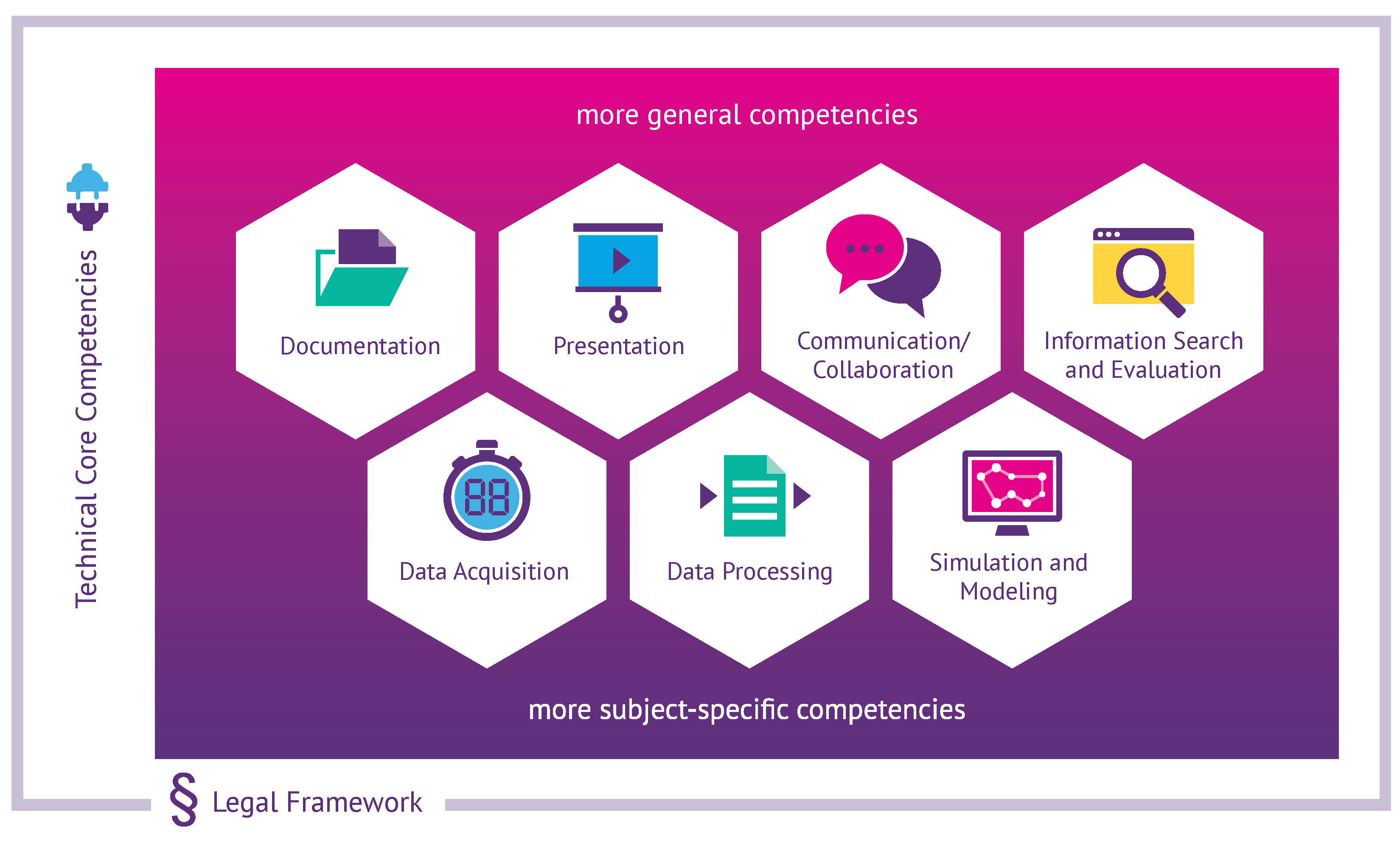
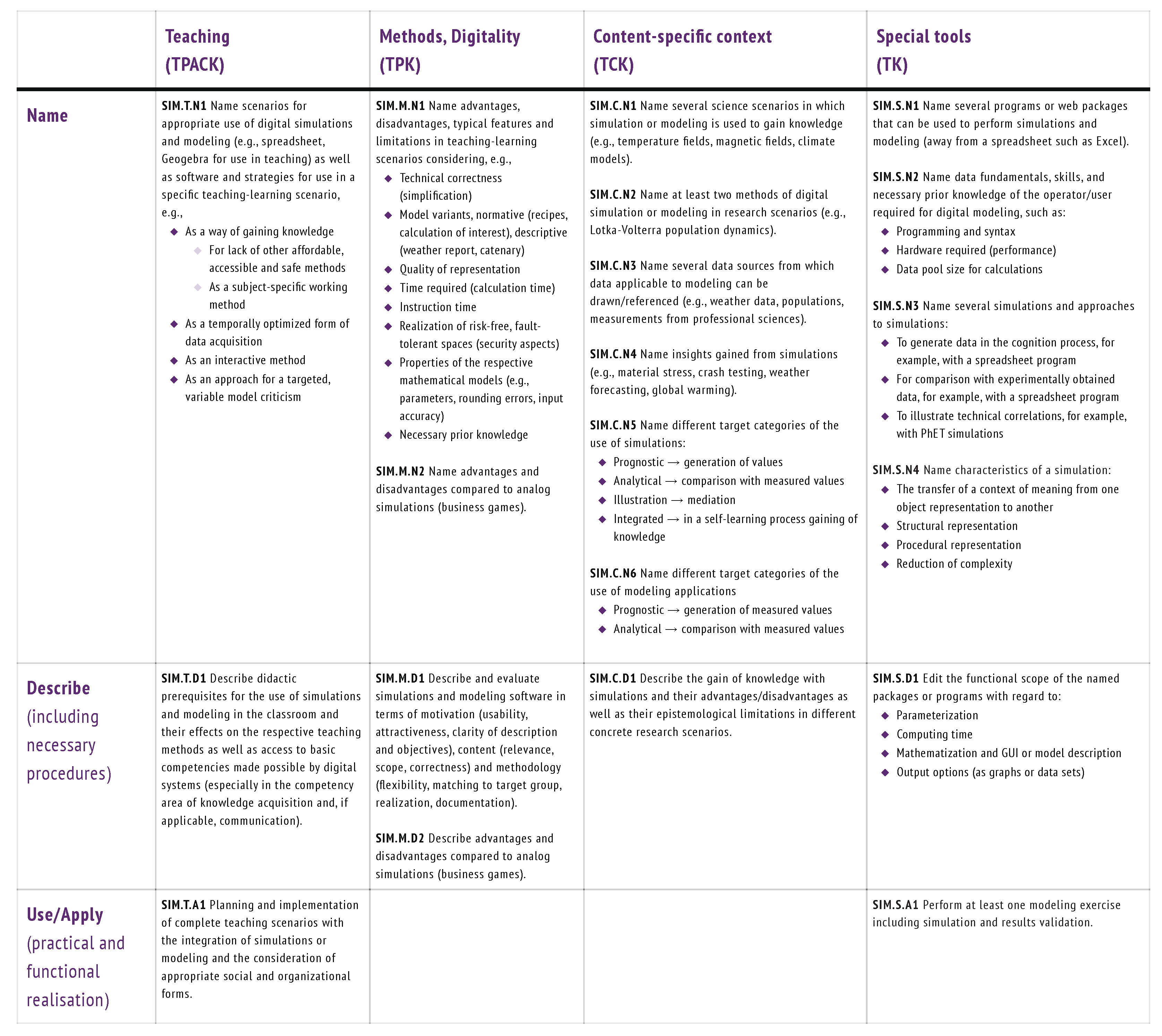
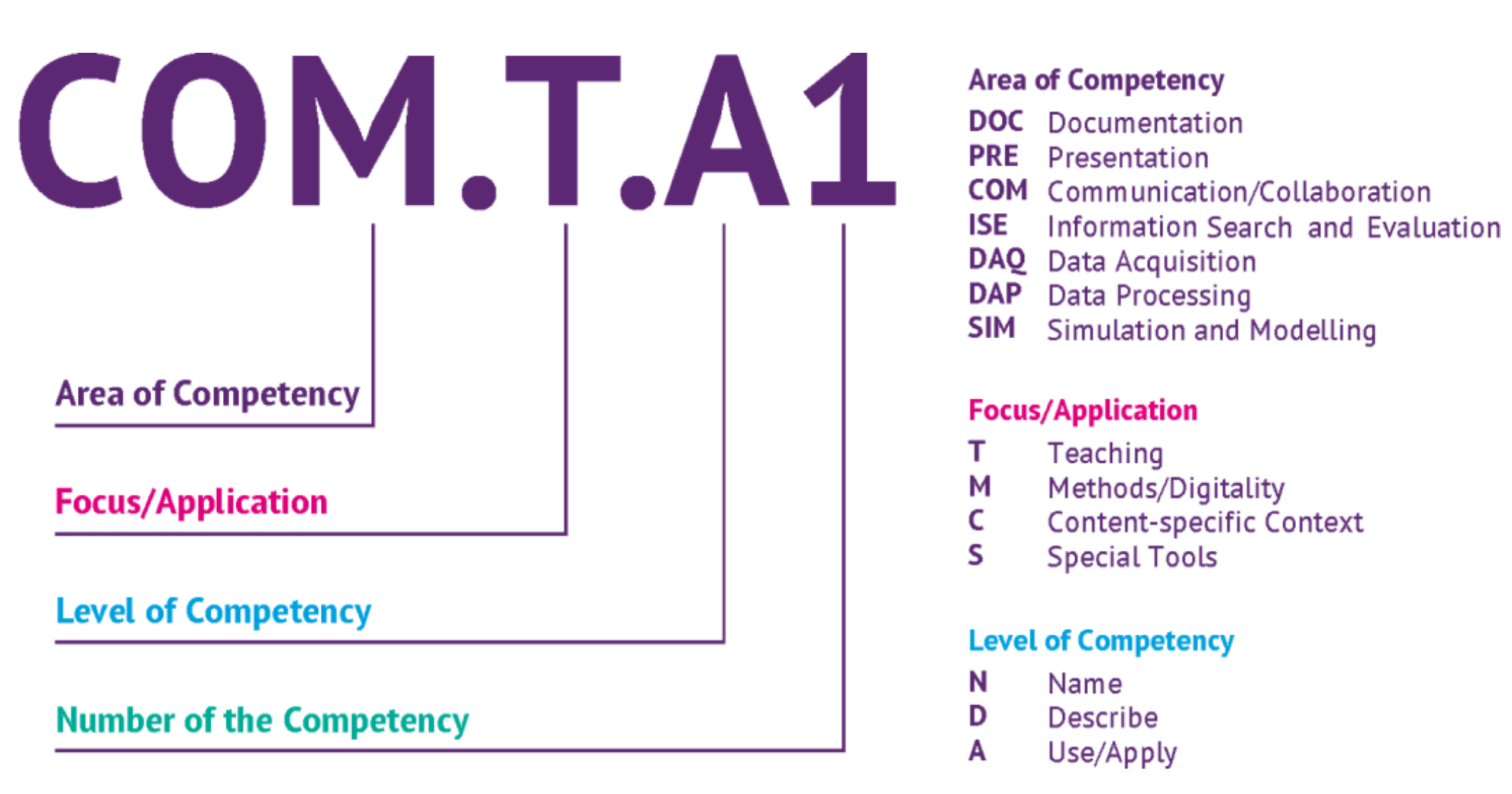


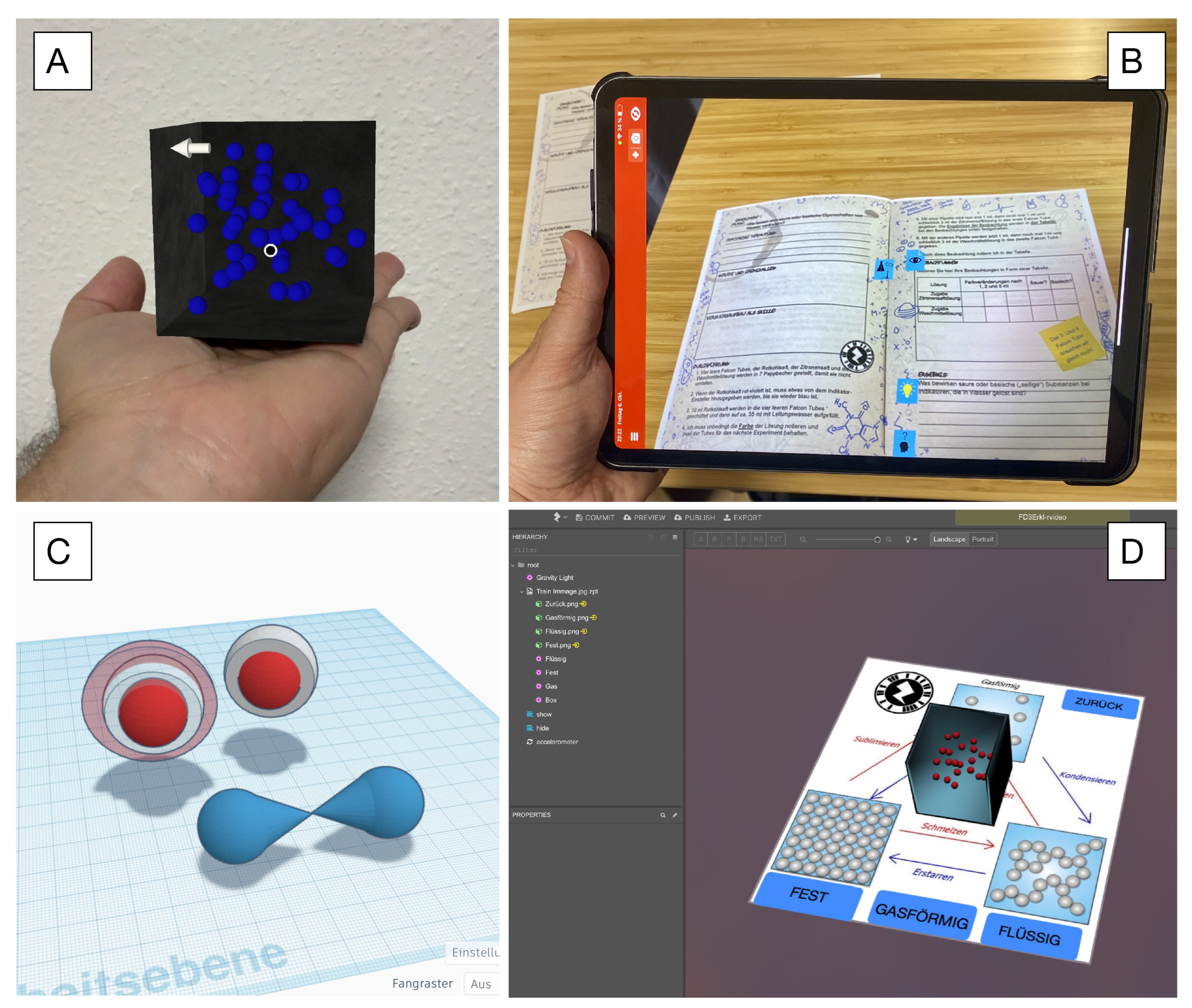
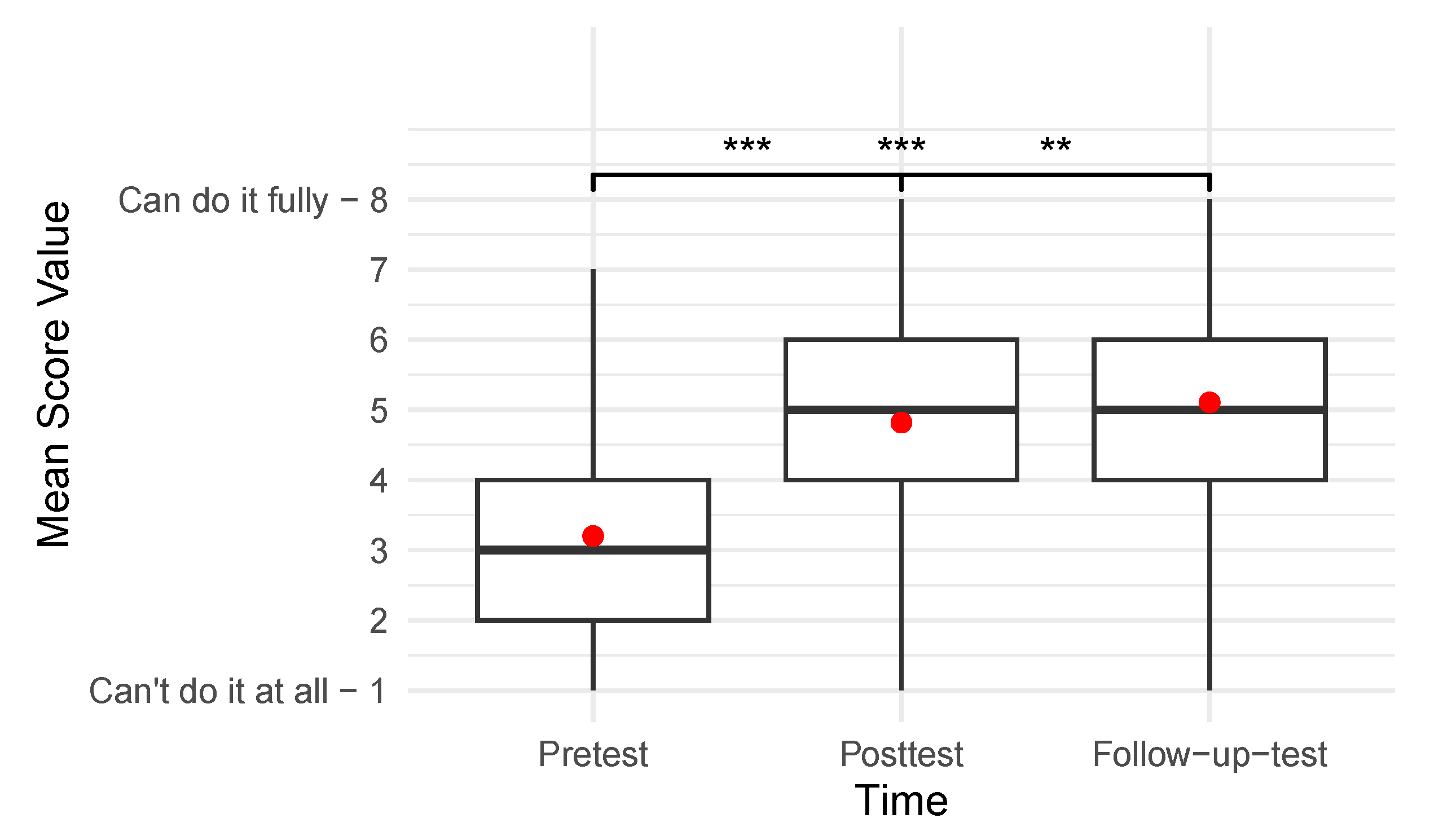
| Pre-Test | Post-Test | |||||||||
|---|---|---|---|---|---|---|---|---|---|---|
| Item | n | M | SD | n | M | SD | V | p | r | Hyp. |
| SIM.S.N1 | 18 | 4.00 | 1.46 | 28 | 5.82 | 1.81 | 136.0 | <0.001 | 0.87 | accept |
| SIM.S.N2 | 18 | 3.06 | 1.55 | 28 | 4.57 | 1.67 | 117.0 | <0.001 | 0.79 | accept |
| SIM.S.N3a | 18 | 2.94 | 1.55 | 28 | 4.79 | 1.64 | 132.0 | <0.001 | 0.79 | accept |
| SIM.S.N3b | 18 | 3.22 | 1.35 | 28 | 5.00 | 1.52 | 129.5 | <0.001 | 0.78 | accept |
| SIM.S.N4 | 17 | 3.12 | 1.36 | 28 | 5.18 | 1.42 | 118.5 | <0.001 | 0.83 | accept |
| SIM.S.D1 | 18 | 2.83 | 1.58 | 27 | 3.93 | 1.44 | 113.0 | 0.0021 | 0.72 | accept |
| SIM.S.A1 | 18 | 2.67 | 1.46 | 27 | 4.70 | 1.81 | 134.0 | <0.001 | 0.83 | accept |
| SIM.C.N1 | 18 | 3.67 | 1.64 | 27 | 5.41 | 1.89 | 145.5 | <0.001 | 0.78 | accept |
| SIM.C.N2 | 18 | 3.50 | 1.65 | 27 | 5.41 | 1.76 | 134.5 | <0.001 | 0.84 | accept |
| SIM.C.N3 | 18 | 3.11 | 1.49 | 27 | 4.52 | 1.53 | 91.0 | <0.001 | 0.81 | accept |
| SIM.C.N4 | 18 | 4.06 | 1.86 | 27 | 5.22 | 1.69 | 82.0 | 0.0054 | 0.62 | accept |
| SIM.C.N5 | 18 | 3.56 | 1.58 | 27 | 4.93 | 1.49 | 110.0 | 0.0026 | 0.69 | accept |
| SIM.C.D1 | 18 | 3.22 | 1.59 | 28 | 4.57 | 1.57 | 89.5 | 0.0021 | 0.75 | accept |
| SIM.M.N1a | 18 | 3.39 | 1.33 | 28 | 5.00 | 1.36 | 136.0 | <0.001 | 0.87 | accept |
| SIM.M.N1b | 18 | 2.89 | 1.53 | 28 | 4.82 | 1.25 | 168.5 | <0.001 | 0.86 | accept |
| SIM.M.N1c | 18 | 3.00 | 1.33 | 28 | 5.07 | 1.39 | 136.0 | <0.001 | 0.87 | accept |
| SIM.M.N2 | 18 | 3.33 | 1.81 | 27 | 5.07 | 1.73 | 114.5 | 0.0021 | 0.76 | accept |
| SIM.M.D1 | 18 | 2.89 | 1.71 | 28 | 4.89 | 1.57 | 150.0 | <0.001 | 0.84 | accept |
| SIM.M.D2 | 18 | 3.28 | 1.90 | 27 | 4.81 | 1.64 | 157.5 | <0.001 | 0.75 | accept |
| SIM.T.N1 | 18 | 3.39 | 1.42 | 28 | 4.68 | 1.59 | 113.0 | 0.0021 | 0.72 | accept |
| SIM.T.D1a | 18 | 3.17 | 1.58 | 28 | 4.68 | 1.36 | 111.0 | 0.0024 | 0.70 | accept |
| SIM.T.D1b | 18 | 3.00 | 1.53 | 28 | 4.39 | 1.50 | 112.5 | 0.0021 | 0.72 | accept |
| SIM.T.A1a | 18 | 2.78 | 1.66 | 28 | 4.18 | 1.52 | 125.5 | 0.0021 | 0.70 | accept |
| SIM.T.A1b | 18 | 2.78 | 1.70 | 28 | 4.04 | 1.62 | 127.0 | 0.0021 | 0.71 | accept |
| Scale | Items | ||
|---|---|---|---|
| ATT | ATT01, ATT04–ATT08, ATT10 | 0.678 | 0.700 |
| MOT | MOT01–06 | 0.857 | 0.886 |
| SUB | SUB01–06 | 0.694 | 0.850 |
| SEE | SEE01–08, SEE01 and SEE04 inverted | 0.835 | 0.880 |
| CON | CON1–3, CON03 inverted | 0.643 | 0.661 |
| Pre-Test | Post-Test | |||||||||
|---|---|---|---|---|---|---|---|---|---|---|
| Item | n | M | SD | n | M | SD | V | p | r | Hyp. |
| ATT | 28 | 3.08 | 0.28 | 28 | 3.20 | 0.28 | 270.5 | 0.02 | 0.49 | accept |
| MOT | 28 | 2.79 | 0.51 | 28 | 3.19 | 0.54 | 255.0 | <0.001 | 0.75 | accept |
| SUB | 28 | 1.80 | 0.38 | 28 | 1.79 | 0.45 | 46.5 | 0.49 | reject | |
| SEE | 28 | 2.42 | 0.40 | 28 | 2.75 | 0.42 | 383.0 | <0.001 | 0.78 | accept |
| CON * | 28 | 1.67 | 0.41 | 28 | 1.71 | 0.39 | 30.0 | 0.30 | reject | |
Disclaimer/Publisher’s Note: The statements, opinions and data contained in all publications are solely those of the individual author(s) and contributor(s) and not of MDPI and/or the editor(s). MDPI and/or the editor(s) disclaim responsibility for any injury to people or property resulting from any ideas, methods, instructions or products referred to in the content. |
© 2023 by the authors. Licensee MDPI, Basel, Switzerland. This article is an open access article distributed under the terms and conditions of the Creative Commons Attribution (CC BY) license (https://creativecommons.org/licenses/by/4.0/).
Share and Cite
Krug, M.; Thoms, L.-J.; Huwer, J. Augmented Reality in the Science Classroom—Implementing Pre-Service Teacher Training in the Competency Area of Simulation and Modeling According to the DiKoLAN Framework. Educ. Sci. 2023, 13, 1016. https://doi.org/10.3390/educsci13101016
Krug M, Thoms L-J, Huwer J. Augmented Reality in the Science Classroom—Implementing Pre-Service Teacher Training in the Competency Area of Simulation and Modeling According to the DiKoLAN Framework. Education Sciences. 2023; 13(10):1016. https://doi.org/10.3390/educsci13101016
Chicago/Turabian StyleKrug, Manuel, Lars-Jochen Thoms, and Johannes Huwer. 2023. "Augmented Reality in the Science Classroom—Implementing Pre-Service Teacher Training in the Competency Area of Simulation and Modeling According to the DiKoLAN Framework" Education Sciences 13, no. 10: 1016. https://doi.org/10.3390/educsci13101016
APA StyleKrug, M., Thoms, L.-J., & Huwer, J. (2023). Augmented Reality in the Science Classroom—Implementing Pre-Service Teacher Training in the Competency Area of Simulation and Modeling According to the DiKoLAN Framework. Education Sciences, 13(10), 1016. https://doi.org/10.3390/educsci13101016









